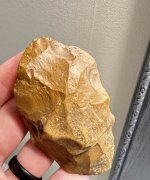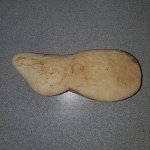hello all, has anyone ever attempted to "retrace" either a union or confederate march?.....reason I ask is this, the same rail line than ran between goldsboro and wilmington was used by thousands of troops, they followed it to get to wilmington, this rail line is still on the same route, with various camps and skirmishes along the way, I am tempted to detect along this route this winter, the route is 165 miles long, I figure i will try to figue out how far a march would go in a days time. I have tons of books with letters talking about walking down the sides of the tracks and such....any ideas and or tips on doing something like this?....I have followed the route using google earth, and it's mostly farmland with dirt roads besides the tracks
You are using an out of date browser. It may not display this or other websites correctly.
You should upgrade or use an alternative browser.
You should upgrade or use an alternative browser.
Retracing civil war marches
- Thread starter rommelvon
- Start date
BioProfessor
Silver Member
If I were in charge of marching troops from point A to point B and had to stop and set up camp along the way, the one thing I would have the advance scout team do is look for water. I doubt if they carried that much with them and that would be one thing they would need lots of. See if you can find sources of water along the route - large and small. I'd bet that would be something that would make them stop. Maybe not overnight all the time but I can't imagine them stopping to camp, cook, etc. without water. Some of the water supplies may be gone but will show up on old maps. I'd put my money on those spots.
Daryl
Daryl
ericwt
Sr. Member
- Feb 8, 2004
- 468
- 13
Yes, I have retraced both Reb and Union marches. However I have found the most productive hunting is tracing retreat routes.
When you have the enemy chasing you it is very common to dump your heavy items that might be slowing you down.
These are productive hunts and are usually on private property. So with permission from the property owner are completely free of legal headaches.
BioProfessor nailed your question on the head. But remember, with retreat routes water was commonly used to dump excess weight without leaving it to the enemy.
When you have the enemy chasing you it is very common to dump your heavy items that might be slowing you down.
These are productive hunts and are usually on private property. So with permission from the property owner are completely free of legal headaches.
BioProfessor nailed your question on the head. But remember, with retreat routes water was commonly used to dump excess weight without leaving it to the enemy.
experience along rail road right away. Remember a location where the right away was wide enough to offer good detecting however the artifacts came from a skirmish in a field nearby. Heavily posted the owner had major problems of "jerks" sneaking in at night and detecting his field. Seeking permission to detect had been ruined here along with many other sites.
Being an imported "yankee" I was accepted by "rebel" detectorist after helping to restore and fence in a family cementary. A twenty two year old Confederate Captain was buried in this plot. His head stone had been broken which we repaired and reset. In the corner of the family plot was a bench from which his father read to his son daily from his bible. Dad died of a heart broken heart within a year. Many experiences such as this happened during my ten years living in the Shenadoah Valley of Virginia
Being an imported "yankee" I was accepted by "rebel" detectorist after helping to restore and fence in a family cementary. A twenty two year old Confederate Captain was buried in this plot. His head stone had been broken which we repaired and reset. In the corner of the family plot was a bench from which his father read to his son daily from his bible. Dad died of a heart broken heart within a year. Many experiences such as this happened during my ten years living in the Shenadoah Valley of Virginia
Shortstack
Silver Member
- Jan 22, 2007
- 4,305
- 416
- Detector(s) used
- Tesoro Bandido II and DeLeon. also a Detector Pro Headhunter Diver, and a Garrett BFO called The Hunter & a Garrett Ace 250.
- Primary Interest:
- All Treasure Hunting
I think you'll want to get your hands on a book titled,Finding Civil War Campsites in Rural Areas by David Poche Associates. It's out of print, but Dixie Metal Detectors of Madison, TN. has some copies for $12.95 plus mail costs. This book reports that infantry troops averaged 15 to 20 miles a day; artillery units, about 20 miles; and calvery, about 25 miles. Of course these distances would vary a little depending on the weather and the condition of the troops. The main info in this book covers how to trace marching routes using historical facts overlaid on modern topo maps. Dixie Metal Detectors' website is www.dixie-metal-detectors.com. Good people---check them out. They're CW relics hunters, too.
- Thread starter
- #6
Thanks everyone for the tips and advice, I think this fall I will start this quest, and hopefully find some good stuff, fort fisher is right down the road from me, but it's a big no no to detect there, however there are numerous camps and skirmish sites close to me that I plan on hunting
wildrider
Bronze Member
SWR said:15 miles a day comes to mind
Yup, came to my mind too.
BioProfessor
Silver Member
If you have a fort close by, find out EXACTLY where the boundaries are. Hunt there and a little ways beyond. Modern day boundaries have nothing to do with what went on at the camp. Heck, their dump was most likely outside the boundary. That would be a nice place.
Daryl
Daryl
- Apr 5, 2007
- 348
- 220
- Detector(s) used
- Minelab eTrac, Minelab Equinox 800, Minelab Excalibur II, Whites MXT, Tesoro Tejon
I am currently reading a soldiers diary and this is some good info. If you company did the march, thne do a search for a soldiers diary from that company. I am reading about Lt. Cornelius C. Platter from the 81st Ohio Infantry Volunteers and his march with Sherman from November 1864 - April 27, 1865. This is helping me with finding some areas to investigate.
Good luck!
Good luck!
Top Member Reactions
-
 2142
2142 -
 981
981 -
 948
948 -
 945
945 -
 844
844 -
 798
798 -
 796
796 -
 681
681 -
 557
557 -
 545
545 -
 482
482 -
 478
478 -
 458
458 -
O
444
-
 436
436 -
 430
430 -
 417
417 -
 406
406 -
 373
373 -
 359
359
Users who are viewing this thread
Total: 2 (members: 0, guests: 2)





